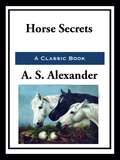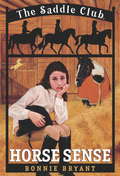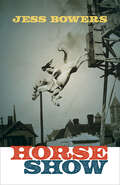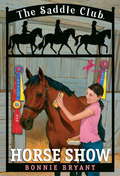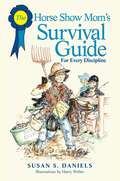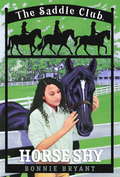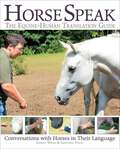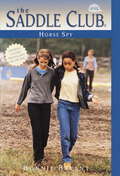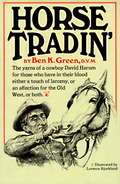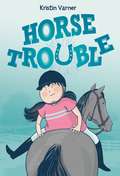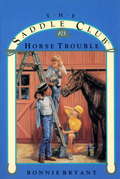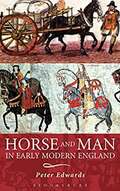- Table View
- List View
Horse Safety
by Elizabeth Moyer Jean AbernathyHorse Safety is a guide to equine safety that gives reliable advice on understanding equine instincts and moods, approaching a horse properly, leading, and working safely around horses. The book gives an overall picture of good horsemanship and emphasizes safe tying (including where to tie, how to use cross ties, and how to tie a quick-release knot) as well as keeping a safe barn and preparing for emergencies. The book also covers pasture safety and riding safety (in the arena and on the trail), including how to find the proper fit for equipment and tack such as helmets and saddles.
Horse Secrets
by A. S. AlexanderDr. A. S. Alexander, the writer and compiler of &“Horse Secrets,&” has had upward of 25 years&’ experience in matters pertaining to agriculture, horse breeding, veterinary science, press writing and teaching. He was the author of the first stallion service legislation and inspection regulation in America, the first law of the kind having been written by him and enacted by the Wisconsin Legislature in 1905. Similar legislation now is in force in some 16 other states, and it is accomplishing much for the improvement of horse breeding. Horse trading offers unusual opportunities and temptations for sharp practises. Both buyer and seller equally need to be horse-wise and alert. Dishonesty is discountenanced in the great horse markets, but it is common among scalpers, &“gyps&” and small traders outside of the recognized markets and is likely to be practised by either the buyer or the seller. The items published in these pages disclose many sharp practises which, aside from their interest as facts not generally known, are valuable as information for the man who would engage intelligently in horse buying and selling. The writer and publishers of this book desire to expose these tricks, and to decry their practise in the markets and among outside dealers and breeders. &“Forewarned is forearmed,&” and the information here given will doubtless save many a man from loss, and tend to make dishonesty less rife because less likely to succeed. In mentioning the various tricks herein disclosed, the exact methods have not been given in detail. We have no desire to instruct readers so that they may &“go and do likewise&”; for the same reason doses have not been given for the administration of the various drugs and &“dopes&” used by tricksters.
Horse Sense (Saddle Club #3)
by Bonnie BryantLisa love being a member of the Saddle Club. But lately, Stevie and Carole haven't had time for her or their friendship. And if she can'tconvince her friends that their club is just as important, she may have to find new members to replace them. . . .
Horse Sense and Nonsense: A Survival Guide for Horse Lovers
by Jean Abernethy Cindy HaleHorse lovers know all too well that keeping a horse is practically a full-time job-with lots of fun and, well, goof-ups. <P><P>For those new horse owners who sometimes wonder if their horse is smarter than they are, Horse Sense and Nonsense is a great reminder that the "joys" of owning a horse are universal. This refreshing spoof of the usually staid horse owner's manual blends common-sense advice with side-splitting spins on the issues of horses and horse ownership. Whether nodding your head in agreement or giving a hearty horse laugh, you'll delight in reading Horse Sense and Nonsense.
Horse Senses (Manson Ser.)
by Susan McBaneHorses perceive the world differently from humans because their senses developed differently through evolution to cope with different ways of living and surviving. Horses are essentially prey/flight animals. The horse's senses therefore determine how the world appears to him and how he reacts to it. As the horse's perception and understanding are v
Horse Show
by Jess BowersFrom the tale of Lady, the mare who read a Duke University psychologist' s mind, to television palomino Mr. Ed' s hypnotic hold over Wilbur Post, the thirteen tales in Horse Show explore how humans have used, abused, and spectacularized their equine companions throughout American history. Wrestling with themes of obsolescence, grief, and nostalgia, Bowers guides us through her museum of equine esoterica with arresting imagery, unflinching intensity, and dark humor.
Horse Show (Saddle Club #8)
by Bonnie BryantTO THE SADDLE Club, there's nothing more exciting than riding horses at Pine Hollow - until they're invited to New York City to watch the American Horse Show! Max's former student, Dorothy DeSoto, will be competing, and the girls will get a backstage view of competitive riding. And in their free time, Lisa, Carole, and Stevie might just get to be the star of their own show - on the big screen!
Horse Show Heist (The Amazing Adventures of the DC Super-Pets)
by Steve KorteWhen Supergirl and her super-horse, Comet, enter a horse show, thieves show up to ruin the day. Can the super-pair win the gold, stop the bad guys, and keep Supergirl’s identity a secret?
Horse Show Mom's Survival Guide: For Every Discipline
by Susan DanielsAt some point in a mother's life, her child--most likely, her daughter--will smile sweetly and say, "Mommy, I want to learn to ride a horse. And then I want to win a blue ribbon."What's a mother to do? (Or for that matter, a father, since he'll become involved too, even though ferrying the child to and from lessons and competitions is far more often the equivalent of a Soccer Mom.) Even people who rode when they were younger may not remember the ins and outs of the sport, and especially the way it's played these days.Riding to the rescue comes Susan Daniels, an experienced and accomplished Horse Show Mom. Taking the perplexed parent under her wing, she provides advice on locating a suitable lesson stable (including how to tell whether a particular instructor is right for your child, and what to do if he or she isn't), determining when - or whether - to buy a horse or a pony, outfitting horse and rider (must the animal's leg wraps and the child's ponytail ribbons match?), and understanding and coping with stable politics (such as when it's appropriate for barn managers and instructors to pay more attention to another youngster than to yours).When it comes to horse showing, the author explains how to tell when your child is ready for competition, what's expected of horse and rider at various levels of proficiency, which supplies Moms should always have on hand (safety pins and hair nets lead the list), how to deal with your child's triumphs and tears, and how to understand the complicated but crucial national and regional championship points systems.With pages of warm and encouraging humor, sound advice and illustrative true-life adventures from the worlds of hunter/jumper, Western, combined training, and dressage competition, The Horse Show Mom's Survival Guide is a valuable "leg up" for any parent whose youngster has that blue-ribbon gleam in her eye.
Horse Shy (Saddle Club #2)
by Bonnie BryantWhen one of Pine Hollow's students makes a terrible mistake, causing a tragic accident, Carole is done with riding forever. Unless Stevie and Lisa can remind her what friendship and the Saddle Club are all about.
Horse Speak
by Sharon Wilsie Gretchen VogelHorse Speak is not a training method or technique—it is a practical system for &“listening&” and &“talking&” to horses in their language, instead of expecting them to comprehend ours. Horse Speak can be used by anyone who works with horses, whether riding instructor, colt starter, recreational rider, or avid competitor. It promises improved understanding of what a horse is telling you, and provides simple replies you can use to tell him that you &“hear&” him, you &“get it,&” and you have ideas you want to share with him, too. The result? Time with your horse will be full of what horse trainer and equine-assisted learning instructor Sharon Wilsie of Wilsie Way Horsemanship calls Conversations, and soon the all-too-common misunderstandings that occur between horse and human will evolve into civil discussions with positive and progressive results! Learn Horse Speak in 12 easy steps; understand equine communication via breath and body language; and discover the Four Gs of Horse Speak: Greeting, Going Somewhere, Grooming, and Gone. Practice regulating your intensity, and sample dozens of ready-made Conversations with your horse, as step-by-step templates and instructional color photographs walk you through the eye-opening process of communicating on a whole new level.
Horse Spy (Saddle Club #94)
by Bonnie BryantThe President and his horse-crazy daughter will be visiting Washington. Carole invites the girl to come for a ride at Pine Hollow. Security men walk around Pine Hollow, asking for security clearance for horses. But what happens when a real spy turns up?
Horse Stories (Basic Vocabulary)
by Marguerite P. Dolch Edward W. DolchThe books in the Basic Vocabulary Series are written with charm of style and high interest appeal for the children. Children love to read them for fun and thus get a vast amount of practice in reading skills. A high literary quality has been maintained in writing these true stories of animals, and retelling tales of folklore.
Horse Tales: Timeless and Compelling Stories of Horses and Their Riders
Our relationship and fascination with horses have been evident in every civilization and throughout recorded history. No better proof can be found than in literature, in the stories and poetry that capture the endless variety of partnerships between horses and riders. Horse Tales is a compilation of the best of these works and include tales penned by:Mark TwainH. H. MunroNathaniel HawthorneWashington IrvingWinston ChurchillEnid BagnoldLeo TolstoyBret HarteZane Greyand many, many others.
Horse Talk (Saddle Club #71)
by Bonnie BryantWillow Creek Junior High School gets its own radio station and Saddle club hosts a call-in show. Initially nobody calls, then Stevie's brother's friends call asking silly questions. A caller then tells about a horse in trouble. Is the call for real?
Horse Thief
by Robert Newton PeckAfter losing two fingers in his first bull ride, seventeen-year-old Tullis Yoder worries he'll never have a chance to top another bull. Then the rodeo show he works for goes broke, and he learns that its thirteen horses, his only family, will be slaughtered for dog meat. With the help of a lady doctor and an aging professional horse thief, Tullis steals his beloved horses. He wants to set the horses free, but with crooks, three sheriffs, and a powerful judge after him, will he have a chance?
Horse Thief (Saddle Club #83)
by Bonnie BryantThe Saddle Club is taking part in a big Pony Club rally being held at Pine Hollow. Riders from all the local Pony Clubs are there, including Stevie's boyfriend, Phil Marsten. For once Stevie and Phil aren't being too competitive so everyone is having a good time--until a thief spoils the fun by stealing $500 from the stable office. Veronica diAngelo says she saw Phil hanging around the office and acting suspiciously. And Phil did need money. But he'd never resort to theft, would he? Is Veronica up to something? Or is there a thief among the riders? It's up to the Saddle Club to find out and clear Phil's name.
Horse Tradin'
by Ben K. GreenHere are the yarns of a true cowboy for those who have in their blood either a touch of larceny, an affection for the Old West, or better yet, both. These twenty tales add up to a true account of Ben K. Green's experiences around the corrals, livery stables, and wagon yards of the West. Green was a veterinarian who took down his shingle and went into horse trading, in what he imagined would be retirement. No stranger to the saddle, Green claims to have "with these bloodshot eyes and gnarled hands measured over seventy thousand horses. " His tales range from tricks to make an old horse seem young (at least until the poor creature died from the side effects of the scam) to a recipe for making a dapple-gray mule from a bucket of paint and a chicken's egg. So you want to go into the horse business? You can learn the knavery, skill, salesmanship, and pure con man hokum of horse trading here, in a book every westerner or horse fancier should have on hand. Copyright © Libri GmbH. All rights reserved.
Horse Training In-Hand
by Ellen Schuthof-Lesmeister Kip MistralWorking the horse from the ground—schooling in-hand as it has been known for centuries—has long been an integral part of classical horse training. Now, this gorgeously illustrated book explains in clear, step-by-step lessons how the modern-day horse owner can incorporate classical groundwork in her daily interactions with her equine partner—to both their benefit and enjoyment.Whether schooling green or young horses; retraining problem horses or those with poor foundations; warming-up advanced mounts prior to workouts; confirming lateral movements on the ground before attempting them on horseback; or supplementing everyday under-saddle exercises, work in-hand provides a wonderful way to advance the horse's education, as well as the standard of communication between horse and handler. Its gradual progression of work on the longe, double-longe, long lines, short reins, and long reins is the perfect addition to the training program that has grown a little stale or boring; the manageable solution to countless problems that commonly arise in daily work with horses; and by definition, an equestrian art form unto itself.With over 100 color photographs—including many detailed series shots—to demonstrate correct body positioning, and meticulously hand-drawn illustrations to guide you through the often-confusing land of lateral work,Horse Training In-Handis the first bookeverto help shed classical groundwork's mystique while conscientiously preserving its magic. Find out for yourself how schooling in-hand can give your training program a brand new look and feel, forever transforming workouts and schooling sessions into artistic endeavors that yield breathtaking results.
Horse Trouble
by Kristin VarnerAn American Library Association 2021 Best Graphic Novel for ChildrenTwelve-year-old Kate is laser-focused on her one true passion: horseback riding. But try as she might, she can't hide from life's problems in the stable.There's nothing Kate loves more than being around horses. But her best friend is allergic to them, so Kate has to take riding lessons without her. Kate's forced to navigate some of life's hardships—like the mean girls at the stable who tease her and her body insecurities—all on her own. To make matters worse, Kate is continually falling off her horse. To Kate, her tween years feel like one unfair punishment after another. Can she get over it all…and get back on her horse?Horse Trouble, the debut graphic novel from children's book artist Kristin Varner, is an oh-so-relatable graphic novel with humor and heart.
Horse Trouble (Saddle Club #23)
by Bonnie BryantWhen Mrs. Reg, the manager of Pine Hollow Stables, goes away for a few days, The Saddle Club is determined to pitch in and keep things running smoothly. Lisa, Carole, and Stevie decide they know everything there is to know about horses, so they'll have no problem managing a stable for a few days...right? Wrong! instead it seems that every time the girls try to help, disaster quickly follows. More paint winds up on one of the horses than on the stable; several riders don't get quite the ride they expect; and Mrs. Reg's paperwork is in utter chaos. Soon the members of The Saddle Club are wondering if being horse crazy is all they need to manage the stable, after all!
Horse Whispers (Saddle Club #74)
by Bonnie BryantThe Saddle Club finds her running with a herd of wild horses that lives on the Bar None land. They bring the mare back. She runs away again. They bring her back again, only to have her run away once more.
Horse Wise (Saddle Club #11)
by Bonnie BryantWHEN MAX ANNOUNCES that Pine Hollow will begin its own Pony Club, Stevie, Carole, and Lisa are excited to know they're about to become even more knowledgeable about horses. But spoiled Veronica is more focused on riding her new horse than learning how to take care of him. The Saddle Club won't soon forget what happened with Veronica's last horse, Cobalt. And when it looks like she's headed for the same trouble again, the girls are quick to act--but are they already too late?
Horse Wise: Thinking Outside the Stall and Other Lessons I Learned from My Horse
by Cheryl KimballHorses teach life's great lessons--keep it simple/ learn to think differently/ lead by respect, not dominance/ consider the horse's (other person's) perspective. Horse Wise is full of horse sense and human common sense. Horsewoman and author Cheryl Kimball uses endearing real-life stories of working with horses to tell readers what her horses have taught her about managing a company, being a leader for employees in times of trouble, and how to live everyday life more deeply and authentically.Among the many valuable lessons horses have taught Kimball over the years are:* Learn to Control Your Anger* Leadership is an Important Thing* The Importance of Consistency* Don't Force Things* Be HumbleReaders don't need a horse to apply the life lessons of Horse Wise. Sharing stories from her horse world, Kimball explains how the lessons learned from the horse apply to the world of people and our relationships with each other--and ourselves.Funny and poignant stories show readers that when we put ourselves in a horse's shoes, we gain compassion and wisdom--and we get what we need.
Horse and Man in Early Modern England
by Peter EdwardsHorses were used for many purposes in Shakespeare's England: for travel, either on horseback or in carriages, for haulage and for pleasure, and for work in the fields. The upper classes were closely involved with horses, for jousting, hunting and racing. Horses was also essential to any army, both as cavalry and to draw supplies and artillery. Horse ownership was, however, much more widespread than might be imagined. <p><p> Horse and Man in Early Modern England shows how, in pre-industrial England, horses were bred and trained, what they ate, how much they were worth, how long they lived, and what their owners thought of them. <p><p> While they were named individually, and sometimes became favourites, many were worked hard and poorly treated, leading to their early deaths. They were, nevertheless an essential part of the life of the time and are strikingly depicted in literature and art, as well in many other records.

